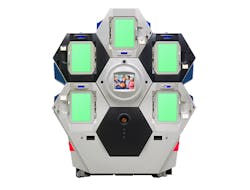For years stadiums have struggled to balance the need to provide enhanced security with a desire by fans to have easy entry into these venues. After all, people entering a stadium to watch a sporting event or concert do not expect to undergo the same type of rigorous screening they are subjected to at the airport. But last week’s bombing at the Stade de France stadium in Paris proved what security experts have warned about for years which is that sporting venues can and will be targeted by terrorist groups.
Perhaps the biggest bone of contention between fans and stadium security has been over the screening of bags. Two years ago, the National Football League implemented a new bag policy that only allows clear plastic, vinyl or PVC bags to be brought into games and these bags cannot exceed 12 inches by six inches by 12 inches. This obviously ruffled a few feathers among fans, especially women who were also not permitted to carry their purses into games.
Aside from the inconvenience, many people are also uncomfortable with having security personnel rummage through their personal items. One company that is looking to revolutionize how bags are screened is Silicon Valley-based Qylur Intelligent Systems.
The company has developed an automated, self-service security screening system that enables people to submit their bags for screening without assistance from a guard. According to Qylur Vice President Yair Dolev, the Qylatron Entry Experience Solution is a large, portal-like system arranged in a shape similar to a beehive that contains five hexagonal cells for the screening of bags.
“People that are coming into the stadium go to the front of the Qylatron solution and they open the front doors of cells, which are like locker doors, they put their bags in and then they move to the back after they go through a metal detector. As they are screened for anything on them, the bags get screened inside the Qylatron and then they take their bag and go in the stadium,” explained Dolev. “There are hardly any guards involved physically and, normally, no one touches your bag or your belongings.”
The system, which was used at the World Cup in Brazil last year, was recently installed at Levi’s Stadium in Santa Clara, Calif., marking the company’s first commercial deployment in the U.S. The system is currently only being used for the stadium’s daily tour program and select private events. While the Qylatron solution may have gained traction in the stadium market initially, Dolev believes that its’ applications are appropriate for a broad array of vertical markets.
“We are targeting the entire private sector of large venues, which includes stadiums and arenas, theme parks, tourist attractions – museums and national monuments – as well as airports,” he said. “The partnership with Levi’s Stadium is really for introducing a whole new way of managing the entry process and together with them we’re going to be developing and defining best practices for stadiums. We certainly intend to showcase that to the rest of the industry and we will no doubt be helping others to follow in our footsteps in terms of deploying that.”
Although the system is capable of performing hundreds of scans within the span of an hour, Dolev said the effective throughput really depends on how the venue is going to be using it, whether they allow only one person per scan or let multiple people scan their belongings within a cell at a given time. And while the fans may not see a large physical security presence at the stadium’s entrance, Dolev said that doesn’t mean the role of screening personnel will be diminished when it comes to checking bags.
“Of course there is somebody, whenever something is discovered, to take control of a bag and perform a manual search if necessary,” he said. “And although the system performs automated detection of some of the most important threats, there’s also a screener located remotely in the control center or command post of the stadium, that has access to the images in real time and they can communicate back if they see additional things. They can basically stop bags for anything they see. There’s really a collaborative detection process here, both the machine can flag something and the screener can also flag something. The machine is great at finding some things while a human is best at others and together we have the best of both worlds.”
Dolev said the company has received “overwhelmingly positive” feedback from both those that have used and implemented the system. The Qylatron solution is also unique in that it is actually able to learn and become more efficient over time by leveraging machine learning technology.
“Part of our appeal to Levi’s Stadium was our use of intelligent technology. Qylatron is running onsite and part of what it does is automated detection for some of the more important threats posed by hidden items in bags,” said Dolev. “Behind the Qylatron there is a whole infrastructure that we’re running online in the cloud – a machine-learning, big data analysis infrastructure – that is supporting the machine in the background. With the machine onsite and the other layer online, it enables the machine to not only do automated detection, it also helps it evolve and learn from how contents in the bag change or if there are new discoveries being made at other sites. This whole apparatus, if you will, enables systems to keep learning and fine tuning their detection.”
About the Author
Joel Griffin
Editor-in-Chief, SecurityInfoWatch.com
Joel Griffin is the Editor-in-Chief of SecurityInfoWatch.com, a business-to-business news website published by Endeavor Business Media that covers all aspects of the physical security industry. Joel has covered the security industry since May 2008 when he first joined the site as assistant editor. Prior to SecurityInfoWatch, Joel worked as a staff reporter for two years at the Newton Citizen, a daily newspaper located in the suburban Atlanta city of Covington, Ga.

